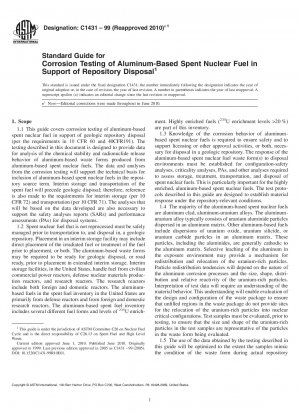ASTM C1431-99(2010)e1
Standard Guide for Corrosion Testing of Aluminum-Based Spent Nuclear Fuel in Support of Repository Disposal
- Standard No.
- ASTM C1431-99(2010)e1
- Release Date
- 1999
- Published By
- American Society for Testing and Materials (ASTM)
- Status
- Replace By
- ASTM C1431-99(2018)
- Latest
- ASTM C1431-99(2018)
- Scope
Disposition of aluminum-based spent nuclear fuel will involve:
Removal from the existing storage or transfer facility,
Characterization or treatment, or both, of the fuel or the resulting waste form, or both,
Placement of the waste form in a canister,
Placement of the canister in a safe and environmentally sound interim storage facility,
Removal from the interim storage facility and transport to the repository,
placement in a waste container,
Emplacement in the repository, and
Repository closure and geologic disposal. Actions in each of these steps may significantly impact the success of any subsequent step.
Aluminum-based spent nuclear fuel and the aluminum-based waste forms display physical and chemical characteristics that differ significantly from the characteristics of commercial nuclear fuels and from high level radioactive waste glasses. For example, some are highly enriched and most have heterogeneous microstructures that include very small, uranium-rich particles. The impact of this difference on repository performance must be evaluated and understood.
The U.S. Nuclear Regulatory Commission has licensing authority over public domain transportation and repository disposal (and most of the interim dry storage) of spent nuclear fuels and high-level radioactive waste under the requirements established by 10 CFR 60, 10 CFR 71, and 10 CFR 72. These requirements outline specific information needs that should be met through test protocols, for example, those mentioned in this guide. The information developed from the tests described in this guide is not meant to be comprehensive. However, the tests discussed here will provide corrosion property data to support the following information needs.
A knowledge of the solubility, leaching, oxidation/reduction reactions, and corrosion of the waste form constituents in/by the repository environment (dry air, moist air, and repository relevant water) (see 10 CFR 60.112 and 135).
A knowledge of the effects of radiolysis and temperature on the oxidation, corrosion, and leaching behavior (see 10 CFR 60.135).
A knowledge of the temperature dependence of the solubility of waste form constituents plus oxidation and corrosion products (see 10 CFR 60.135).
Information from laboratory experiments or technical analyses, or both, about time dependence of the internal condition of the waste package (see 10 CFR 60.143 and 10 CFR 72.76).
Laboratory demonstrations of the effects of the electrochemical differences between the aluminum-based waste form and the candidate packaging materials on galvanic corrosion (see 10 CFR 71.43) or the significance of electrical contact between the waste form and the packaging materials on items outlined in 4.3.1-4.3.4 (see 10 CFR 60.135), or both.
Information on the risk involved in the receipt, handling, packaging, storage, and retrieval of the waste forms (see 10 CFR 72.3).
Information on the physical and chemical condition of the waste form upon repository placement so that items outlined in 4.3.1-4.3.4 can be evaluated (see 10 CFR 60.135).
Knowledge of the degradation of the waste form during interim storage so that operational safety problems with respect to its removal from storage can be assessed, if such removal is necessary (see 10 CFR 72.123).
Knowledge of the condition of the waste form prior to repository placement so that items outlined in 4.3.1-4.3.4 are properly addressed (see 10 CFR 60.135).
Conditions expected during each stage of the disposition process must be addressed. Exposure conditions anticipated over the interim storage through geologic disposition periods include dry and moist air, and aqueous environments. The air environments are associated with interim storage and the early stages of repository storage while the aqueous environments arise after water intrusion into the repository has cau......
ASTM C1431-99(2010)e1 Referenced Document
- ASTM C1174 Standard Practice for Prediction of the Long-Term Behavior of Waste Package Materials Including Waste Forms Used in the Geologic Disposal of High-Level Nuclear Waste
ASTM C1431-99(2010)e1 history
- 2018 ASTM C1431-99(2018) Standard Guide for Corrosion Testing of Aluminum-Based Spent Nuclear Fuel in Support of Repository Disposal
- 1999 ASTM C1431-99(2010)e1 Standard Guide for Corrosion Testing of Aluminum-Based Spent Nuclear Fuel in Support of Repository Disposal
- 1999 ASTM C1431-99(2005) Standard Guide for Corrosion Testing of Aluminum-Based Spent Nuclear Fuel in Support of Repository Disposal
- 1999 ASTM C1431-99 Standard Guide for Corrosion Testing of Aluminum-Based Spent Nuclear Fuel in Support of Repository Disposal
